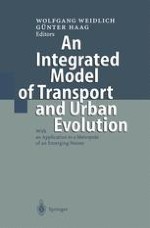1999 | OriginalPaper | Buchkapitel
The Integrated Transport and Evolution Model
verfasst von : Prof. Dr. Dr. h.c. Wolfgang Weidlich, Prof. Dr. Günter Haag
Erschienen in: An Integrated Model of Transport and Urban Evolution
Verlag: Springer Berlin Heidelberg
Enthalten in: Professional Book Archive
Aktivieren Sie unsere intelligente Suche, um passende Fachinhalte oder Patente zu finden.
Wählen Sie Textabschnitte aus um mit Künstlicher Intelligenz passenden Patente zu finden. powered by
Markieren Sie Textabschnitte, um KI-gestützt weitere passende Inhalte zu finden. powered by
The impact of transport infrastructure on regional development has been difficult to verify empirically in Europe (Wegener in WP 7, EUROSIL, 1998). There seems to be a clear positive correlation between transport infrastructure endowment or the location in interregional networks and the levels of economic indicators such as GDP per capita (e.g. Biehl, 1986; 1991; Keeble et al. , 1982, 1988). However, this correlation may merely reflect historical agglomeration processes rather than causal relationships effective today (cf. Brocker and Peschel, 1988). Attempts to explain changes in economic indicators, i.e. economic growth and decline, by transport investment have been much less successful. The reason for this failure may be that in countries with an already highly developed transport infrastructure further transport network improvements bring only marginal benefits. The conclusion is that transport improvements have strong impacts on regional development only where they result in removing a bottleneck (Blum, 1982; Biehl, 1986; 1991). In China the situation is quite different. There is a growing need for an expansion of transport infrastructure on the urban level, the regional and national levels.
